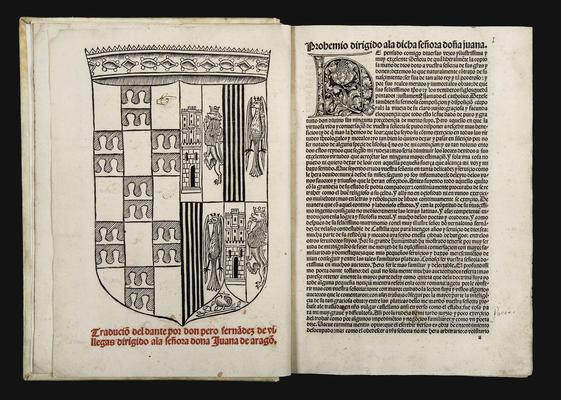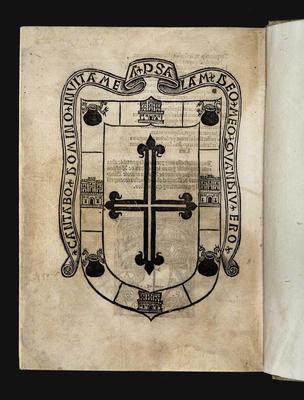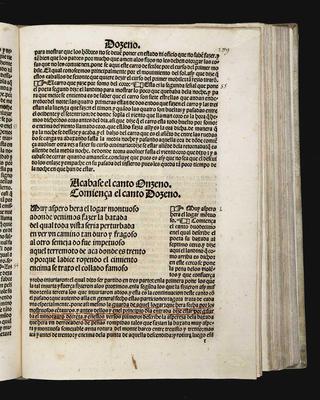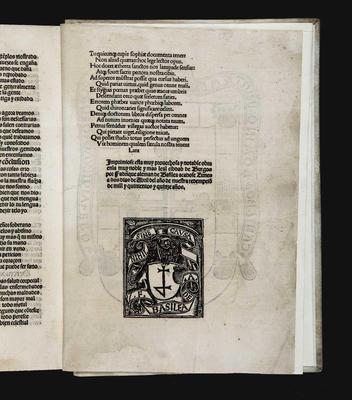Dante Alighieri
La traducion del dante de lengua toscana en verso castellano: por el Reuerendo don pedro fernandez de villegas arcediano de burgos... Con otros dos tratados, uno que se dize querella de la fe. y otro auersion del mundo y conuersion a dios.
Burgos, Fadrique Alemán de Basilea, 2 April 1515.Folio (281x207 mm). Collation: (8, a-z8, 78, cum8, A-O8, P-Q6. [331] of [332] leaves. The first leaf with title and privilege (often lacking in the recorded copies), here supplied in facsimile. Gothic and roman type. Contemporary pagination, in brown ink. On the recto of the last leaf woodcut printer's device. On the fol. signed (8v full-page woodcut arms of Joanna of Aragon, with two dedicatory lines printed in red; on the verso of the last leaf full-page woodcut coat of arms of the editor Pedro Fernández de Villegas. Finely decorated and animated woodcut initials. Twentieth-century vellum. Smooth spine with inked title and imprint. In the Suma delo contenido a contemporary hand has added the page-numbering in red; underlinings in text by the same hand. A good copy, the first and last leaves browned; in the first quire small repairs to the outer blank corners; the margins of the last leaf restored; small stains in places. A few marginal notes by a later hand.
Provenance: on fol. signed (2r an early nineteenth-century Spanish ownership inscription, barely legible but dated '27 Enero 1819'; Livio Ambrogio collection.
The very rare first printed translation of a cantica of the Commedia into a foreign language,the Inferno translated into Castilian verses by the humanist Don Pedro Fernández deVillegas (1453-1536), archdeacon of the cathedral of Burgos. The edition was commissioned by the beautiful and erudite Joanna of Aragon Queen of Castile, the second daughter of Queen Isabellaiand King Ferdinand the Catholic, and generally, though unjustly, known as Joan the Mad.
The volume was published by Fadrique Alemán, i.e Friedrich Biel from Basel, who in 1485 set up the first printing press in Burgos. The text of Dante's poem is accompanied by the commentary of Villegas, who used Cristoforo Landino's Comento of 1481 as his main source, but re-interpreted from an orthodox Catholic point of view, and omitting the Neoplatonic readings of the Florentine humanist. Don Pedro also made a wide use of Patristic literature, writings by Thomas Aquinas, Antoninus of Florence, Alexander of Hales, and other traditional Catholic sources. Villegas criticises some of what he deems to be Dante's inappropriate expressions, and condemns obscenities in some cantos of the Inferno: a moralistic reading which could be seen as anticipating the Spanish Inquisition's later attitude to Dante (in 1612 the Commedia was included in the Index librorum prohibitorum, and three passages in the text in particular were censored and deleted in the copies held in Spanish libraries). The edition, which also contains two brief moral works by Villegas himself, has been praised for the elegance of its mise-en-page with the commentary surrounding the text, the handsome woodcut initials, the alternation of red and black, and the neat gothic type used for printing. A curious feature of the translation is the choice of the eight-line stanza, normally associated with vernacular epic poetry, rather than the original terzine as the metrical scheme.
The Infierno of Villegas represents the apogee of Renaissance Iberian dantismo. A fine copy of an edition that rarely comes onto the market, despite the lack – as usual in the recorded copies, owing to the presence of the Royal privilege – of the first leaf, here skilfully supplied in facsimile.





